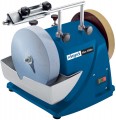Motor power
Rated power of the electric motor of the machine. The more powerful the engine, the higher the speed and intensity of processing can be, the larger discs can be used with the machine and the better it is suitable for working with hard, stubborn materials. On the other hand, a powerful motor consumes a lot of energy (which may require special connection — see "Power") and significantly affects the dimensions, weight and price of the entire unit. Therefore, manufacturers choose this parameter based on the type (see "Machine") and the desired characteristics of speed, productivity, etc. In fact, this means that engine power is rather a secondary parameter, and when choosing, it makes sense to pay attention to more practical points — disk diameter, rotation / movement speed, etc.
Disc diameter
Regular diameter of the disk (see "Working element") used by the machine for dry processing (see above). When grinding and polishing, usually, we are talking about the maximum diameter of the disk that can be installed on the tool — a larger nozzle will either be ineffective or not fit into the dimensions of the seat at all, but a smaller diameter disk, usually, is installed without problems (of course, if the hole diameter matches — see below). For grinding machines, the diameter of the disc corresponds to the diameter of the sanding pad, which is necessary for the full use of the disc.
The larger the regular disk — the heavier and more powerful the machine, usually, the better it can cope with complex work of a large volume. At the same time, for small everyday tasks like periodically sharpening knives or chisels, a small disc is quite enough.
Bore diameter
The bore diameter of the dry cutting discs (see above) used by the machine. In order for the nozzle to be used normally with the machine, it must match it not only in diameter and thickness (see the relevant paragraphs), but also in the size of the mounting hole.
Disc speed
The nominal speed of rotation of the disk for dry processing (see above), provided by the machine; for models with adjustable rotation (see below), the maximum rotation speed.
For the same disc diameter and material, a higher speed provides more intensive processing, and a slower rotation contributes to accuracy and precision. In addition, optimal speeds depend on the composition of the disc and the material being processed; detailed recommendations with specific figures for a particular situation can be found in special sources.
A separate category is grinding machines with disk-shaped working elements: in such units, the actual speed of movement of the disk surface relative to the workpiece depends on how close the contact point is to the centre of the disk.
Disc diameter
Regular diameter of the disk (see "Working element") used by the machine for wet processing. Unlike dry sharpening, in this case, this parameter most often describes not the maximum, but the optimal diameter of the nozzle for a given machine: a disc that is too small may simply not reach the liquid poured into the working bath.
If the machine is purchased for infrequent everyday use, this parameter can be ignored; but for large volumes of work it is recommended to use larger discs.
Bore diameter
Bore diameter of the wet cutting discs used by the machine. In order for the nozzle to be used normally with the machine, it must match it not only in diameter and thickness (see the relevant paragraphs), but also in the size of the mounting hole.
Disc thickness
The thickness of the "wet" disk for which the machine is designed. Usually, we are talking about the maximum thickness of the disc that can fit on the seat — most models allow the use of thinner nozzles. However, the classic
universal sharpening is usually carried out in a wet way (see “Sharpening”), and the disk for it should be quite thick; therefore it is better to proceed from the fact that in this case the optimal thickness of the disk is indicated.
Disc speed
The nominal speed of rotation of the disc for wet processing, provided by the machine; for models with adjustable rotation (see below), the maximum rotation speed. Compared to "dry" disks, "wet" disks have a very low speed — even in the "fastest" models it does not exceed 3000 rpm; this is due to the nature of the process.
In general, a higher speed, ceteris paribus, has a positive effect on performance, a lower speed on accuracy and accuracy.
Speed controller
The ability to change the speed of movement of the working element of the machine.
The speed controller may have its own characteristics: in some models it is smooth, in others it is stepped, the number of steps may be different, etc. Anyway, speed control greatly expands the capabilities of the machine, allowing you to adjust the mode of operation to the specific situation.

